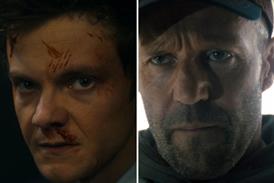So far in 2010, 3D has delivered more than $1bn at the global box office. But with only 8% of global screens equipped for the format, can exhibitors keep up with the flow of product?
Imax or RealD, Avatar or Shrek Forever After - however movie-goers watch them, 3D films are not a passing fad. Up to May 31, the 3D 2010 release schedule has generated $1.42bn worldwide from the combined success of Disney’s Alice In Wonderland, Warner Bros’ Clash Of The Titans and Paramount-DreamWorks’ How To Train Your Dragon and Shrek Forever After, versus 2009’s full-year figure of $3.9bn which was driven largely by Avatar. This year looks to rival 2009’s haul, with a multitude of 3D titles such as Toy Story 3, The Last Airbender, Resident Evil: Afterlife and Tron: Legacy.
3D is booming but the question is not whether this bubble will burst, rather how fast exhibitors can meet studios’ demands. The record box-office figures for the format are currently derived from only 8% of the world’s estimated 150,000 screens; a tight space when 23 titles this year are clamouring for theatre time followed by another 27 in 2011. Too often, 3D titles are leaving screens earlier than theatre chains would like.
“It’s essential that exhibitors speed up their conversion because 3D films are coming,” says Paramount Pictures International president Andrew Cripps.
The prevailing studio philosophy is that if they release it the audience will come, and converting 2D films into 3D (as with Titans), coupled with the flood of titles, will not hamper business. “There’ll be more action, horror and genre films in 3D than ever,” says Sony Pictures Releasing International president Mark Zucker on the expansion of product beyond tentpole and animated films. Genre titles such as Amityville 3-D and Metalstorm: The Destruction Of Jared-Syn fared poorly at the box office during the 1980s, stalling a 3D trend. However, distributors believe horror and thrillers have a better chance in today’s market given the improvement in technology. For example, Warner’s release of The Final Destination earned 75% of its $66.5m US gross in 3D, while the format propelled its overseas box office past $100m.
Studios estimate there are 11,700 3D screens worldwide, a figure which improves on the Motion Picture Association of America’s 2009 tally of 8,989. US research firm Display Search projects 7,000 additions in 2010. Despite the surges that have occurred ahead of the summer movie season, around 61% of 4,375 3D digital sites internationally still have just one screen in the theatre.
“There’s a definite need for exhibitors to screen multiple 3D titles in the same complex,” says Warner Bros president of international distribution Veronika Kwan-Rubinek. “At a minimum, there should be at least two 3D screens per complex.”
Nonetheless, 3D remains a touchy topic between exhibitors and the studios, as theatrical chains bear the brunt of refitting their theatres to digital at $100,000 per auditorium; a prerequisite before upgrading to 3D for another $26,000-$30,000.
China’s government has fuelled its expansion, while US chains AMC, Cinemark and Regal are financing 14,000 additional digital screens in a $660m shared financial consortium. Other countries lean on private funding. But the biggest bone of contention between theatres and studios remains 3D glasses, which certain studios subsidise based on their relationship with the exhibitor. Disposable glasses can cost as little as $0.60, whereas reusable ones are around $17. In the long run, reusable sets drive down the cost per patron.
Exhibitors have passed the cost of 3D digital cinema to consumers by as much as $5 in the US and $2.50-$3.70 (£2-£3) in Europe. But such hikes do not appear to be scaring families away. Like a theme park ride, 3D is a price worth paying. “It’s like that feeling you get before leaving on a cool trip. You have butterflies,” says Greg Foster, chairman and president of Imax Filmed Entertainment.
Look no further than IMAX as a barometer for movie-goers’ 3D appetite and their willingness to pay premium prices. Driven largely by Avatar, IMAX saw a banner fourth quarter in 2009 with its profit (EBITDA) shooting up seven-fold to $20.9m and its revenues up 98% to $54.2m on the same frame a year ago. Now, 2010 has seen further year-on-year gains thanks to 3D titles Alice In Wonderland and How To Train Your Dragon and 2D titles such as Iron Man 2, which set an IMAX 2D opening record with $9.8m (8% of the US’s $128.1m first weekend). 3D IMAX launches can generate as much as 11% of a film’s opening figure.
“An IMAX auditorium does about five times the box office on a digital 3D film than 2D,” says IMAX CEO Richard L Gelfond. IMAX is looking to swell its worldwide count of 438 auditoriums by another 1,000 locations, with the bulk of that expansion being at 600 venues outside the US. IMAX signed 41 new theatre-system contracts between January and March this year, a portion being joint ventures with international chains such as South Korea’s CJ CGV and Russia’s Rising Star Media. IMAX’s most ripe market for 3D digital is China, where it expects to double its current 27-theatre count by 2012.
Billed as a major cost-saver for exhibitors and distributors, the digital transition is happening more slowly than initially predicted - and not just because of the financial crisis.
At ShoWest in 2008 there was an excited buzz generated by the $25m weekend box-office gross of Meet The Robinsons. The animated feature was not expected to be much of a hit, but fuelled by 600 3D digital engagements - out of 3,400 - it surprised the industry. It was not the first 3D movie or success in the format but somehow its timing galvanised as never before the zeal for conversion from celluloid.
Floored by the response, Joe Peixoto, RealD president, worldwide cinema, stuck his tongue in cheek and joked: “I guess [digital 3D] can do just about anything except cure cancer.”
Industry pundits predicted there would be 15,000 digital screens in the US by the end of 2009; 5,000 capable of showing 3D. There was wild talk of free trials of digital equipment, easy financing terms, studio monetary support and a box-office boom which would pay for it all in less than five years.
Twenty-seven months later, none of the predictions have panned out as expected and the slowdown in the transition cannot be exclusively credited to the global financial meltdown.
“Everyone’s watching their bottom line and being cautious about digital,” observes Pacific Theatres’ president Jerry Forman. Additionally he cites the physical logistics of producing and installing equipment as key factors in what he sees as a transition that will not be complete prior to 2020.
There are currently more than 9,000 digital screens in the US and Canada, including 4,400 with 3D capability. Additionally there are 10,000-plus digital screens in the rest of the world, of which 7,300 are equipped with the digital format. The US/Canada 3D figure translates to an approximate 22% market share of all digital screens worldwide. And to no great surprise, the screens - in any part of the global marketplace - are predominantly in urban areas and at theatres which are part of major chains or significant regional players. Prior to the late April release of Iron Man 2, 3D digital films - Avatar, Alice In Wonderland, Clash Of The Titans - were the top grossing box-office ticket sellers globally for 19 consecutive weeks.
Four companies manufacture digital projectors - Barco, Christie, Sony and NEC - and according to industry sources, none carries a significant stock. But for the present, the demand for an estimated 400 screen conversions globally per month is being met, and with a recently secured $660m financial package by the three national US movie circuits, the number of digital screens should double by the end of 2012.
Additionally, the major studios forged a deal with movie circuits to pay a ‘virtual print fee’ to defray their investment in new technology. The arrangement is rumoured to be $850 per engagement and will eventually pave the way for millions in annual savings on what the studios currently pay in shipping costs. But those savings are in the future. Warner Bros distribution executive Jeffrey Goldstein confirmed his studio had not seriously altered its lab orders for 35mm prints but the situation could change when 2012 budgets are drawn up.
Meanwhile, independents and operators with fewer than 20 screens in the US are anxious to at least convert a single screen to digital. But with costs ranging from $75,000 to $100,000, many cannot secure financing. The National Association of Theatre Owners initiated a programme to target this issue and a meeting at the most recent ShoWest attracted the largest number of delegates. Progress is being made, according to an organisation officer, but as yet there is no formal financing plan.
Finally there is the elephant in the room: digital technology. Anecdotally there have been countless tales of disc errors, system breakdowns, invalid product keys and the like. But brushing that aside, the sector has made major strides in the past five years and those who bought the first generation of digital projectors have either updated or attempted to work with obsolescence. There remains a giant question mark as to whether industry-set standards will be out of date in five or 10 years, and judging from the past, the likely answer is that change will be a difficult and evolving process.
3D digital screens by territory (to May 2010)
Territory No of screens
US 4,400
China 1,360
France 924
UK 500-plus
Germany 500-plus
Italy 425
Russia 400
Australia 312
Japan 309
Spain 265
Mexico 245
Worldwide digital/3D screen breakdown
Total number of screens: 150,000
Total number of digital screens: 19,200
Total number of digital screens which are
3D: 11,700
Recent titles: 2D and 3D worldwide
box-office breakdown (to May 31)
Avatar 20th Fox
2D $630m (23%)
3D $2.1bn (77%)
Total $2.73bn
Alice In Wonderland Walt Disney SMP
2D $300.4m (30%)
3D $701m (70%)
Total $1bn
Clash Of The Titans Warner Bros
2D $189.8m (39%)
3D $292.6m (61%)
Total $482.4m
How To Train Your Dragon Paramount/DreamWorks
2D $151.4m (33%)
3D $306.3m (67%)
Total $457.7m
Shrek Forever After Paramount/DreamWorks
2D $77.1m (38%)
3D $123.2m (62%)
Total $200.3m
3D releases’ global box office
2010 for 3D titles also playing in 2D
Total from four films $2.14bn
Total from 3D $1.42bn (66%)
2009 for 3D titles also playing in 2D
Total from 15 films $6.09bn
Total from 3D $3.9bn (64%)
Source: Major studios






















No comments yet